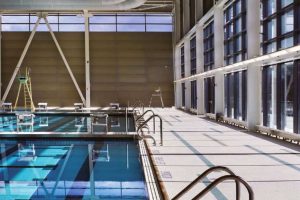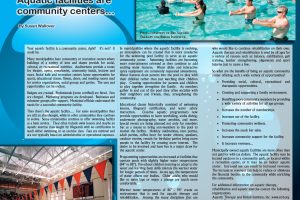At Wallover Architects, we’ve long believed that aquatic centers are more than just places to swim. They’re spaces where health, connection, and education come together—true community centers in every sense. In a featured article in Recreation Management (May 2010), Susan Wallover, Director of Recreation Planning at Wallover Architects, explored this very idea: how aquatic centers can (and should) evolve to serve communities more holistically. Today, that vision is more relevant than ever.
Rethinking the Aquatic Center
Many municipalities have community or recreation centers that host everything from concerts to fitness classes—but too often, aquatic facilities remain underutilized or single-purpose. Wallover challenged this status quo by urging decision-makers to rethink swimming pools not just as seasonal amenities, but as essential infrastructure for education, therapy, recreation, and family engagement.
Health and Wellness Anchored in Design
A modern aquatic center can cater to a wide range of user needs:
-
Therapeutic Warm Water Pools for aging adults and rehabilitation
-
Learn-to-Swim Programming for children and water safety education
-
Aquatic Exercise Classes for all ages and fitness levels
-
Social Gathering Spaces like splash zones and family-friendly features
By elevating water temperatures slightly (to 86–94°F), for example, facilities can comfortably accommodate seniors and toddlers alike, while improving access for aquatic therapy sessions.
Programming That Drives Participation
Wallover noted that creative programming is critical. Today’s top-performing facilities offer:
-
Snorkeling and water photography workshops
-
Holiday and themed events
-
Senior coffee hours and teen nights
-
Birthday party rentals and community movie nights
These events increase engagement, bring in new users, and ultimately boost revenue for municipalities—making aquatic centers both vibrant and financially sustainable.
Designing for Accessibility and Functionality
Informed by decades of aquatic facility experience, Wallover Architects emphasizes the importance of thoughtful, inclusive design. Whether it’s:
-
ADA-compliant access ramps and lifts
-
Energy-efficient filtration systems
-
Multi-use pool zones (lap, leisure, therapy)
…every element contributes to a center that serves the broadest possible audience while minimizing operational costs.
Projects like the Sewickley Valley YMCA Renovation and the Freedom Village Therapy Pool are examples of how we’ve helped communities revitalize their aquatic offerings with purpose-built features that drive usage and value.
Conclusion: Building Community Through Aquatics
Aquatic centers can and should be catalysts for community development, personal wellness, and social connectivity. Wallover Architects continues to lead the way in transforming public and private aquatic facilities into modern community hubs that meet evolving needs.
Whether you’re planning a new center or revitalizing an aging one, our team brings unmatched expertise in design, programming, and execution. Let’s create the next great aquatic experience—together.
📞 Contact us today at ewallover@walloverarchitects.com to explore our design services.




